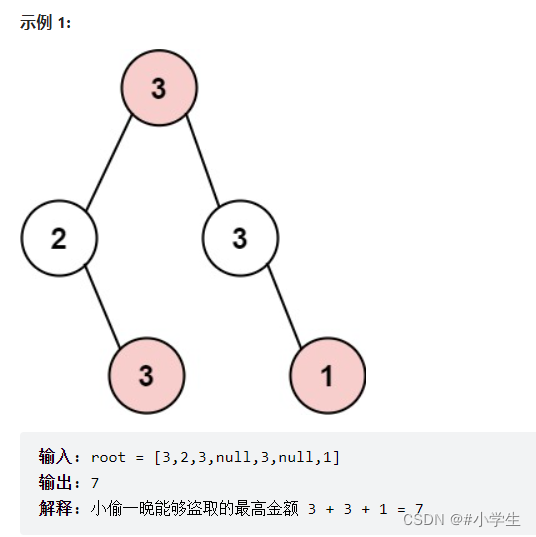-
LeetCode337:打家劫舍III
要求
小偷又发现了一个新的可行窃的地区。这个地区只有一个入口,我们称之为 root 。除了 root 之外,每栋房子有且只有一个“父“房子与之相连。一番侦察之后,聪明的小偷意识到“这个地方的所有房屋的排列类似于一棵二叉树”。 如果 两个直接相连的房子在同一天晚上被打劫 ,房屋将自动报警。
给定二叉树的 root 。返回在不触动警报的情况下, 小偷能够盗取的最高金额 。


思路
不能盗取父子相连的房子
方法一:记忆化搜索
把每次的结果存储起来,下次再计算的话,从缓存中取,避免重复计算;二叉树不适合数组存储,所以使用哈希表进行存储结果public int rob(TreeNode root) { HashMap<TreeNode, Integer> map= new HashMap<>(); return robInternal(root, map); } public int robInternal(TreeNode root, HashMap<TreeNode, Integer> map) { if (root == null) return 0; if (map.containsKey(root)) return map.get(root); int money = root.val; if (root.left != null) { money += (robInternal(root.left.left, map) + robInternal(root.left.right, map)); } if (root.right != null) { money += (robInternal(root.right.left, map) + robInternal(root.right.right, map)); } int result = Math.max(money, robInternal(root.left, map) + robInternal(root.right, map)); map.put(root, result); return result; }- 1
- 2
- 3
- 4
- 5
- 6
- 7
- 8
- 9
- 10
- 11
- 12
- 13
- 14
- 15
- 16
- 17
- 18
- 19
- 20
方法二:动态规划
从下往上遍历 —> 从子节点往父节点去遍历,一层层向上汇报,也就是后序遍历:左右根1、状态定义:dp[node][j] :这里node表示一个以node为根节点的树,规定了是否偷取能获得最大值
- j = 0,表示node节点不偷取;
- j = 1,表示node节点偷取;
2、推导状态转移方程:根据当前节点是否偷取,进行转移
- 如果不偷取当前节点,左右子节点都可以偷或不偷,选最大值
- 如果偷取当前节点,左右子节点都不可以进行偷取
3、初始化:节点为空,返回0,对应后序遍历时候的递归终止条件
4、在根节点时,返回两者状态最大值public class LeetCode337 { public int rob(TreeNode root) { int[] res = dfs(root); return Math.max(res[0],res[1]); } private int[] dfs(TreeNode root) { //终止条件, if (root == null) { return new int[]{0, 0}; } //后序遍历:先计算左右子节点的值,在计算当前结点的值 int[] left = dfs(root.left); int[] right = dfs(root.right); //dp[0]:以当前node为根节点的子树能够偷取的最大价值,规定node节点不偷 //dp[1]:以当前node为根节点的子树能够偷取的最大价值,规定node节点偷 int[] dp = new int[2]; dp[0] = Math.max(left[0], left[1]) + Math.max(right[0], right[1]); dp[1] = root.val + left[0] + right[0]; return dp; } }- 1
- 2
- 3
- 4
- 5
- 6
- 7
- 8
- 9
- 10
- 11
- 12
- 13
- 14
- 15
- 16
- 17
- 18
- 19
- 20
- 21
- 22
- 23
- 24
-
相关阅读:
从硬件角度看服务器性能调优
嵌入式-电子电路四个基本定律
UML精简概述
1155掷骰子等于目标和的方法数 (dfs + 记忆化搜索)
C语言详解——操作符讲解
Qt foreach关键字
【单片机基础小知识-如何通过指针来读写寄存器】
Java中的多线程很难?【扫盲研报】
R程序 示例4.3.2版本包 在centos进行编译部署
在二叉树中找到两个节点的最近公共祖先
- 原文地址:https://blog.csdn.net/weixin_46426906/article/details/127583868
